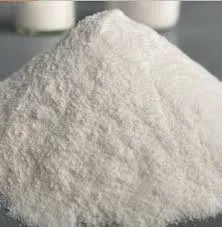
Dùbh . 11, 2024 10:05 Back to list
Understanding the Benefits and Applications of Dispersible Polymer Powder in Modern Industries
Understanding Dispersible Polymer Powder Features and Applications
Dispersible polymer powder has gained significant attention in various industries due to its versatile applications and excellent properties. These powders are designed to be easily dispersed in water or other solvents, leading to the creation of stable polymer dispersions. With a range of unique characteristics and benefits, dispersible polymer powders are finding uses in construction, coatings, adhesives, and more.
What is Dispersible Polymer Powder?
Dispersible polymer powder refers to a fine, dry powder composed of polymer materials that can be readily dispersed in liquids. The advancements in polymer technology have led to the development of these powders, specifically engineered to avoid clumping and to ensure uniform distribution when combined with water or other solvents. They are typically produced from various polymers, including vinyl acetate, styrene, and acrylates.
Key Features of Dispersible Polymer Powder
1. Excellent Solubility Dispersible polymer powders can easily dissolve in water, forming a stable colloidal system. This property is crucial for applications where a smooth, uniform consistency is required.
2. Binding Properties One of the most notable features of these powders is their ability to act as binders. When used in formulations, they enhance the adhesion properties, allowing for stronger connections in coatings and adhesives.
3. Film Forming Dispersible polymer powders can create a continuous film upon drying. This film not only adds mechanical strength to the products but also provides barriers to moisture, which can improve durability and longevity.
4. Compatibility These powders are generally compatible with a variety of other materials, including fillers and pigments. This compatibility allows for the formulation of more complex products without compromising performance.
dispersible polymer powder

5. Low VOC Emissions Many dispersible polymer powders are designed to minimize volatile organic compound (VOC) emissions. This makes them environmentally friendly options that comply with stringent environmental regulations.
Applications of Dispersible Polymer Powder
1. Construction In the construction industry, dispersible polymer powders are widely used in tile adhesives, thin-set mortars, and other cement-based systems. They improve adhesion, flexibility, and workability, making them essential components for modern building materials.
2. Coatings Dispersible polymer powders are used in the formulation of paints and coatings. Their excellent film-forming properties provide benefits such as improved scrub resistance, gloss, and color retention.
3. Adhesives These powders enhance the performance of various adhesives, both in terms of bonding strength and flexibility. Whether for industrial or consumer applications, the use of dispersible polymer powders can significantly improve the efficacy of adhesive formulations.
4. Textiles In the textile industry, dispersible polymer powders are used to enhance the properties of coatings and finishes. They can provide water repellency, stain resistance, and increased durability to fabrics.
5. Personal Care Products The cosmetic industry has also benefited from these powders, where they are used in formulations for creams, lotions, and gels. Their ability to create stable emulsions and enhance the sensory feel of products makes them valuable ingredients.
Conclusion
Dispersible polymer powders represent a significant advancement in polymer technology, offering a host of benefits across various industries. With their excellent solubility, binding capabilities, and low environmental impact, they have become essential components in modern formulations for construction, coatings, adhesives, textiles, and personal care products. As industries continue to innovate, the demand for dispersible polymer powders is expected to grow, leading to further developments and applications that will enhance product performance and sustainability. As we move into a more eco-conscious future, the role of such materials will undoubtedly become even more crucial.
-
Unlocking the Benefits of HPMC Products: A Gateway to Versatile Applications
NewsAug.07,2025
-
Unleashing the Potential of HPMC Ashland: A Comprehensive Look
NewsAug.07,2025
-
Tile Bonding Cellulose: The Key to Superior Adhesion and Durability
NewsAug.07,2025
-
Hydroxypropyl Methylcellulose Powder: The Versatile Component in Modern Pharmaceuticals
NewsAug.07,2025
-
Hydroxyethyl Cellulose: The Versatile Solution for Various Industries
NewsAug.07,2025
-
Hydroxyethyl Cellulose (HEC): The Versatile Polymer for Various Applications
NewsAug.07,2025







